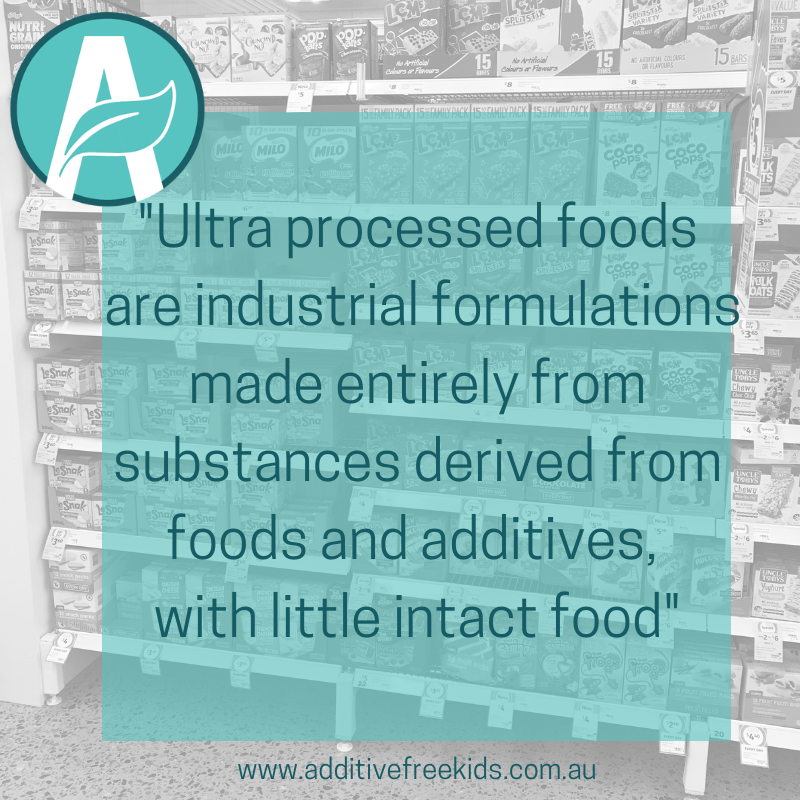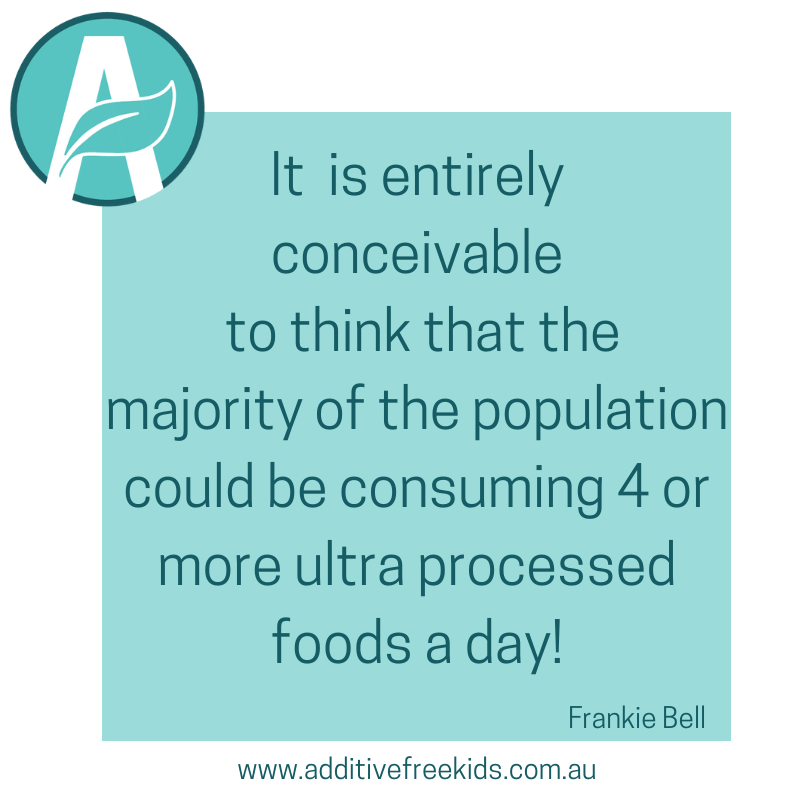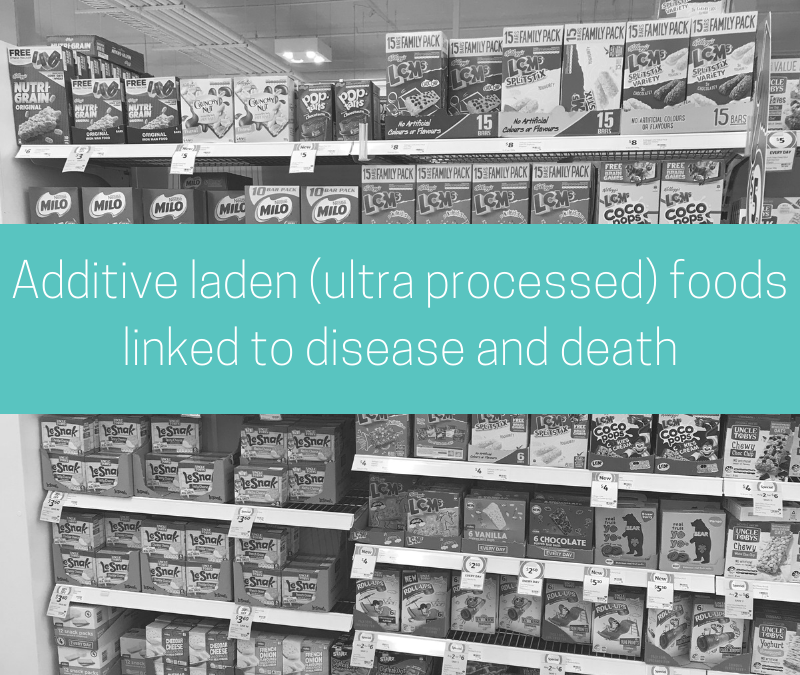The evidence is growing. The additive laden (ultra processed) foods we are feeding ourselves is linked to disease and death. New studies are emerging all the time. These studies highlight what these additives and processed ingredients are doing to us.
Look at the size of our supermarkets now. In the last two decades, we have seen the rise of convenient foods. The availability of ultra processed foods has substantially increased! This isn’t unique to Australia. This is happening around the world. Between 1990 and 2010, the consumption of ultra processed food almost tripled. It went from 11% to 32% of daily energy intake. [1]
What are ultra processed foods?

“ULTRA-PROCESSED FOODS ARE INDUSTRIAL FORMULATIONS MADE MOSTLY OR ENTIRELY FROM SUBSTANCES DERIVED FROM FOODS AND ADDITIVES, WITH LITTLE, IF ANY, INTACT FOOD” [2]
These foods are convenient, ready to eat or heat, really tasty and highly profitable. Think about it. If you are using ingredients that don’t contain a lot of real food, this equals cheap ingredients. Cheap ingredients, results in HIGH profits.
Two new European studies have been released. Both of these studies tracked these adults and their rates of disease for up to 10 years.
1) A French study: Ultra processed food intake and risk of cardiovascular disease [3]
In this study over 105,000 participants aged at least 18 years were monitored. Their dietary intakes were collected using repeated 24hr dietary records. They registered their usual consumption of 3,300 food items. The foods were categorised using the NOVA classification. More on this classification system later.
The results: “…higher consumption of ultra-processed foods was associated with higher risks of cardiovascular, coronary heart and cerebrovascular diseases.”
2) Spanish study: Association between consumption of ultra-processed foods and all cause mortality [4]
In this study nearly 20,000 participants aged 20-91 years were followed up every two years between Dec 1999 and Feb 2014 for food and drink consumption.. Their food was classified according to the degree of processing by the NOVA classification.
The results: “A higher consumption of ultra processed foods (greater than 4 servings) was independently associated with a 62% relatively increased hazard for all cause mortality. For each additional serving of ultra processed food, all cause mortality increased by 18%”
Those are some scary stats!!
Let’s take a look at the NOVA classification system. This will help you to determine what types of foods your family are eating on a daily basis.
NOVA Classification
Foods were classified in 2010 according to their degree of processing. This was last updated in 2016. [5] The NOVA classification assigns a group of food products based on how much processing they have been through. They are grouped into 4 classifications.
Group 1: Unprocessed or minimally processed foods
These are natural foods: edible parts of plants or of animals and also fungi, algae and water, after separation from nature.
Minimally processed foods: these are natural food that are altered by processes that include removing inedible or unwanted parts. Think of processes such as drying, crushing, grinding, fractioning, filtering, roasting, boiling, non-alcoholic fermentation, pasteurisation, refrigeration, chilling, freezing, vacuum packaging.
Group 2: Processed culinary ingredients
These are ingredients such as oils, butter, sugar and salt. They are derived from Group 1 foods or from nature by processes that include pressing, refining, grinding, milling and drying.
These ingredients are not meant to be consumed by themselves. They are usually used in combination with Group 1 foods.
Group 3: Processed foods
Processed foods include foods such as bottled vegetables, canned fish, fruits in syrup, freshly made breads. They are essentially products that are made by adding Group 2 foods to Group 1 foods.
The processes involved include preservation, cooking methods or non alcoholic fermentation.
Group 4: Ultra processed food and drink products
Ultra processed food examples are soft drinks, sweet or savoury packaged snacks, reconstituted meat products, pre-prepared frozen dishes.
These are formulations made mostly or entirely from products derived from foods and additives, with little Group 1 food.
Typical ingredients of ultra processed foods include:
Additives
Preservatives,
antioxidants,
stabilisers,
colours,
flavours,
flavour enhancers,
non sugar sweeteners,
processing aids (firming, bulking, anti-bulking, de-foaming, anti-caking, glazing agents, emulsifiers, sequestrants and humectants).
Hydrogenated oils
Hydrogenated proteins
“CLASSES OF ADDITIVES FOUND ONLY IN ULTRA PROCESSED PRODUCTS INCLUDE THOSE USED TO IMITATE OR ENHANCE THE SENSORY QUALITIES OF FOODS OR TO DISGUISE UNPALATABLE ASPECTS OF THE FINAL PRODUCT”
So now that you have seen the classifications, it is worth working through this for your family. How many servings are they having daily?
GREATER THAN 4 SERVINGS?
The study we referred to earlier concluded:
“A higher consumption of ultra processed foods (greater than 4 servings) was independently associated with a 62% relatively increased hazard for all cause mortality. For each additional serving of ultra processed food, all cause mortality increased by 18%”
Think about how many ultra processed servings your family is having a day! Is it greater than 4? These add up very very quickly!
Let’s take a quick look at a typical day for most families. All we need to do is look at is what is stocked on the supermarket shelves. The products that have the most stock are usually the most popular.
Breakfast
If you are buying packaged cereals from the supermarket, most of these would be considered ultra processed. Anytime you walk into a Coles or Woolworths take a note of how many cereals are stocked. usually the oats and granolas are stocked the least. Every other option will contain additives (of some sort) or highly processed ingredients. They would be classified as ultra processed.
Morning tea
Check out the supermarket aisles. Muesli bars and snack bars feature predominantly. Many of these are ultra processed and their contents no longer resemble food. You need to hunt to find the ones that are minimally processed and still resemble intact food.
Lunch
Given the amount of bread and wraps that are sold in supermarkets, I figure the humble sandwich is highly popular at lunch time.
This sandwich is often made with a highly processed bread that has been fortified with vitamins and minerals. You can’t make a highly processed product healthier by pumping these into the product. Often these sandwiches will contain a yeast based spread, some other spread, or a luncheon meat. All are ultra processed products that contain additives.
Sometimes, the sandwich may be accompanied by a treat, a packet of chips or biscuits. Another ultra processed product.
We haven’t even hit afternoon tea yet….see how quickly the servings add up?!
Afternoon snack
Looking at the supermarket shelves, bakery products feature highly. These bakery products aren’t how bakeries used to make them.
I have watched over the last ten years how the ingredients get swapped out for cheaper, inferior ingredients. They are now ultra processed products.
Dinner
The supermarket shelves are lined with options for the time poor parent. Ready to go pasta sauces and recipe bases. Ready made meals. Pre marinated meats. Most of them will contain a multitude of additives. Unfortunately, the reality is…convenience comes at a cost.
You have to do your research really well to find convenience that isn’t ultra processed.
“It is very conceivable to think that the majority of the population would be consuming 4 or more ultra processed foods a day!”

Time for a rethink!
I don’t want to scare you…
However, I do want to make you rethink….
Our focus in the past has been reformulating packaged foods to remove or reduce their salt, fat or sugar content. To fortify them with fibre and or vitamins.
This isn’t good enough!
The degree of processing must be taken into account. Our food regulation and labelling focuses on salt, fat and sugar. It is time it starts looking at how processed the product is and how many additives it contains!
I highlighted these issues to the Health Star Rating Review. Back in August 2017, I encouraged the AFK community to have their say and submit their comments. I provided the community with some guidance in what they could submit. Some of my comments to the Health Star Rating review centred around:
– The Health Star rating needed to be developed independently from the pressures of Big Food.
– The algorithm should take into account how much processing the food has been through. The least processed the food, usually the healthier the product.
– The Health Star Rating to take into account additives. The more additives in a product, the less healthy it is.
Despite our AFK community pulling together and lodging their submissions, it still fell on deaf ears. There is too much pressure from Big Food to expect change. There was no interest in including additives or the degree of processing in the Healthy Star Rating.
We can’t wait to rely on the government to fix this.
We have to share this knowledge with each other. We need to vote with our dollar every time we buy at the supermarket. Only this way will we get Big Food to start thinking about changing their ways. Actually listening to the consumer. We want convenience. However, we want real food that is minimally processed.
Additive Free Kids can help you
Every time a product is reviewed by Additive Free Kids…. each ingredient is assessed depending on how it has been processed. Not only is it additive free or not.
Additive Free Kids is filling this much needed gap that isn’t being done by our regulators.
We are here to help you navigate which products are not ultra processed.
Any ingredient that has been manipulated past the point of what is reasonable according to the NOVA classification, doesn’t pass our strict tests and won’t get the tick of approval.
Our bodies don’t know how to process these ultra processed ingredients. Our bodies don’t recognise them as food. Is it any wonder that we are seeing these studies linking these ultra processed foods to illnesses and death?
It is time to take matters into your own hands.
Your health is YOUR responsibility.
Don’t wait for the science to catch up.
Don’t wait for the government to make changes.
You can start now.
Start reducing the number of servings of ultra processed foods your family is consuming today. Just choose one thing to change. Take one step at a time. Come and join the AFK email list and receive additive free support, direct to your inbox.
If this blog has resonated with you, please share it with your friends.
References
[1]. Latasa P, Louzada MLDC, Martinez Steel E, Monteiro CA. Added sugars and ultra processed foods in Spanish households (1990-2010). Eur J Clin Nutr 2018;72:1404-12. Doi:10.1038/s41430-017-0039-9 pmid:29277837
[2]. Monteiro CA, Cannon G, Levy R et al. NOVA. The start shines bright. Food classification. Public Health World Nutr 2016;7:28-38
[3]. https://www.bmj.com/content.365/bmj.I1451
[4]. https://www.bmj.com/content.365/bmj.I1949
[5]. https://www.cambridge.org/core/journals/public-health-nutrition/article/un-decade-of-nutrition-the-nova-food-classification-and-the-trouble-with-ultraprocessing/2A9776922A28F8F75BDA32C3266C2A

Frankie Bell is the Managing Director of Additive Free Kids. Frankie is a food coach, mentor and is one of Australia’s leading activists against additives in food.
Frankie is a mum to 5 boys and has personal experience working through the damaging effects of additives to resolve multiple health issues and behavioural problems in her own children. It became Frankie’s purpose to help other families achieve the same improvements for their families.
These changes can be overwhelming, especially for time poor parents. Frankie has done all the hard work for families to ensure they have access to additive free food, anytime, anywhere. See how you can work together with Frankie here


 My passion and mission is to work with families to reduce the overwhelm when going additive free. Moving to additive free living can bring back peace, calm and joy to families. I know it's possible and I've experienced it first hand with my 5 boys.
My passion and mission is to work with families to reduce the overwhelm when going additive free. Moving to additive free living can bring back peace, calm and joy to families. I know it's possible and I've experienced it first hand with my 5 boys.




Such important information, Francine, You are so right in saying ‘we can’t wait for gov’t to fix the problem, we CAN VOTE WITH OUR $$$. The one common thing all people do is eat & food is either nutritious & feeds & nourishes the body or it doesn’t. What you are telling us is that ‘non- food so commonly eaten today not only does not nourish, it is stripping the body of nourishment & causing ill health. It can be hard to hear this message when you are young and time poor, but lose your health and its much harder & more time consuming to get it back. Thanks for your commitment
You are welcome. Thank you for your comment. If we all vote with our dollar we can make change!